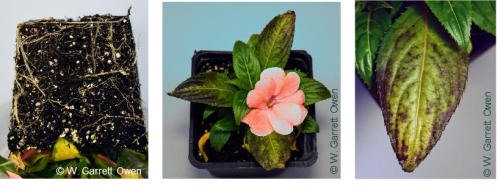Managing substrate pH of soilless substrates
The symptoms of nutrient deficiencies and toxicities are often confused with other issues. To learn more, attend a session for greenhouse and nursery growers in Grand Rapids on Jan. 24, 2018.

Did you know different substrate components in soilless mixes have different pHs? Peat moss and aged pine bark only have a natural pH between 3.0 and 4.0. The optimal substrate pH for most greenhouse and nursery crops, however, is between 5.4 and 6.4 (Figure 1). Therefore, soilless substrate manufacturers add calcitic, dolomitic or hydrated limestone or calcium sulfate to raise the pH into that optimal pH zone.
Every year, Michigan State University Extension floriculture and nursery crops educators encounter situations where the pH of the substrate is either too high or too low for the crop being grown. With over 1,500 species of ornamental plants being grown by Michigan growers, it can be complicated to not only know the pH and electrical conductively (EC) requirements for each crop, but how to grow them effectively using similar media components.
Nutritional disorders can exhibit very different symptoms on different species of plants. For example, one sample of New Guinea impatiens (Figure 2) from last season had lower leaf chlorosis, marginal black spotting, and the dying of leaf tissue. These symptoms are often misdiagnosed and the growers subsequently do not correctly address the problem. In this case, the substrate pH of the New Guinea impatiens plants were 4.6 (recommended 6.0 to 6.5). The low pH caused the iron (Fe) and manganese (Mn) to be overly available to the plant causing a Fe and Mn toxicity. Without testing, this problem may have been misdiagnosed because we often see nutrient deficiencies related to high substrate pH often caused by the very high water alkalinity.

Figure 2. Symptoms of iron (Fe) and manganese (Mn) toxicity because of low substrate pH on New Guinea impatiens. Photos by Garrett Owen, MSU Extension.
There are a few options to correct low pH:
- Apply flowable lime at the rate of 1 to 2 quarts per 100 gallons of water. Be sure to rinse foliage.
- Apply a 1:15 solution of hydrated lime. To do this, mix 1 pound per 3 to 5 gallons of warm water and stir thoroughly.
- Apply potassium bicarbonate (KHCO3) at the rate of 2 pounds per 100 gallons of water. Be sure to rinse the foliage of the plant immediately, leach the substrate and do not over apply.
MSU Extension emphasizes that regularly testing the pH and EC of your crops is essential to preventing nutrient toxicities and deficiencies of crops. Testing is also essential so that accurate diagnosis will lead to appropriate corrective procedures.
For more information, check out these previous MSU Extension articles:
- Different types of limestone to increase media pH
- Commonly used limestones for adjusting pH in greenhouse mixes
- Testing and corrective procedures for low substrate pH
To learn more about how to manage pH for ornamental crops and how alternative substrates effect your pH management, consider attending “Managing Substrate pH and EC for Optimal Plant Nutrition” at the Kent County MSU Extension Office (775 Ball Ave. N.E., Grand Rapids, MI, 49503) on Jan. 24, 2018, from 10 – 11:30 a.m. Register now!



 Print
Print Email
Email




